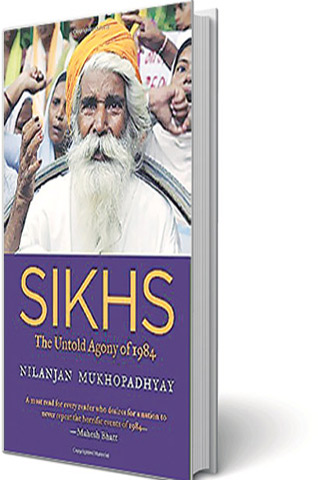Books
New Book On 1984 Fails Yet Again To Identify The Masterminds Of The Genocide
COOMI KAPOOR
SIKHS - THE UNTOLD AGONY OF 1984, by Nilanjan Mukhopadhyay. Westland Tranquebar, India, 2015. Hardcover, English, pp 192. ISBN-10: 9385152513, ISBN-13: 978-9385152511.
It has been over 30 years since murderous mobs armed with iron rods, trishuls and kerosene descended on Sikh homes in Delhi, displaying unspeakable brutality and barbarism.
Sikh homes, businesses and gurdwaras were set on fire, men were stripped of their turbans and burnt alive. Women were forced to watch as male members of their family were dragged out and clobbered to death.
Thousands of innocent Sikhs -- not one of them was guilty or even accused of any wrongdoing! -- were killed in the pogrom in India capital and in cities, towns and villages across the country.
It was the worst communal massacre in post-independent India. Small wonder that the victims of the tragedy refuse to let go of their grief.
Nilanjan Mukhopadhyay, with the deft touch of a skilled reporter, takes us through the tragedy and trauma of the victims of the 1984 pogrom in this book.
Shanti, a middle-aged woman, watched from the terrace as a mob besieged a locked house where her husband and three sons, one an infant, were hiding. The mob poured kerosene on the house and set it ablaze. Shanti could hear the agonising cries of her family as they met their terrible end in the inferno.
She never recovered from the trauma. Her relatives turned down the suggestion of social workers that she be taken to a psychiatric ward in a hospital for counseling. She killed herself shortly afterwards.
Jasmeet Kaur was only 45 days old when Delhi and the surrounding countryside of Haryana went up in flames in the aftermath of Indira Gandhi’s assassination. She and her family were on the run, taking shelter in different houses in Gurgaon to escape the marauding Hindu mobs.
Though she was too young to comprehend the horror, and has heard only eye-witness and historical accounts of the violence, she continues to feel haunted and nervous. She remains fearful of strangers and constantly retreats into a shell.
In contrast, Nirpreet Kaur, whose father was burnt alive by a mob led by local political leaders, has made retribution her lifelong mission. She has become a crusader in the battle for justice for the survivors of the 1984 violence.
Even those who escaped were scarred for life.
A volunteer at a relief camp recalls the distress of those unhappy souls who felt they had lost their identity by being forced to cut their hair and discard their turbans in order to save their lives.
Every Sikh family on the sub-continent and around the world still keeps the memory of 1984 alive.
Mukhopadhyay recounts the unending struggle of the Sikhs to get justice and the unsuccessful attempts of those directly affected by the genocide, to reconstruct their shattered lives.
The author points out that two government inquiries (out of approx twenty such investigations), namely the Misra and the Nanavati Commissions, have not been able to bring about closure and ensure that the guilty are punished. Successive governments have failed to press for trials following the publication of the inquiry commission reports.
There is skepticism too about the Special Investigation Team (SIT) formed by the Modi government in February last year to probe the genocide yet again.
The violence directed at the Sikhs after Mrs Gandhi’s assassination by her two Sikh bodyguards was said to be spontaneous, even though evidence points to a pre-planned and orchestrated pogrom.
While Mrs Gandhi’s body was still lying at AIIMS, the then President Zail Singh’s motorcade was stoned. But there were elements in the Congress Party, assisted by BJP and RSS leaders, who were complicit in instigating the crowds.
The police appeared to have tacit orders to look away as the mobs went on the rampage.
Mukhopadhyay traces the turbulent events which deeply wounded the Sikh psyche and led to the assassination of Indira Gandhi by two individuals acting seeking personal retribution for her crimes against humanity.
However, what is missing in his sympathetic and moving account is a deeper investigation into the role of the guilty. Delhi’s local politicians did not act in isolation. They were spurred on by some unnamed higher authorities, whose identity has never been made public.
[Courtesy: The Indian Express. Edited for sikhchic.com]
January 2, 2016
Conversation about this article
1: Tinku (Punjab), January 05, 2016, 9:15 AM.
Let's not be afraid to call a spade a spade. Congress, BJP, RSS ...? They were just Hindus butchering Sikhs!
2: Arjan Singh (USA), January 12, 2016, 3:38 PM.
The title of this article says it all. After 30 years we have not even been able to 'identify' the masterminds of the anti-Sikh pogroms that were orchestrated all over India. One has to ask this question: if we cannot even identify those responsible then how are we going to prosecute these scoundrels? I honestly believe it is not the failure of this book or its author but the failure of the Sikh community as a whole. Alas, how dysfunctional we have become!



